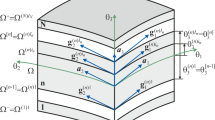Abstract
In this paper, two three-node triangular thin plate/shell elements are proposed based on the absolute nodal coordinate formulation. As the gradient deficient element, the thin plate/shell element does not possess a full Jacobian matrix for the mapping between different configurations. Thus, the formulation cannot be derived in the conventional method directly based on the continuum mechanics. The independent area coordinate gradients with obvious geometrical interpretation are introduced to simplify the derivation of the shape function. To account for the initially curved reference configuration, the curvilinear coordinate system is used as the global structure coordinate system to calculate the Green-Lagrange strain and formulate the elastic force. The tangent plane is built node-wise to transform the global curvilinear structural gradients to the local area gradients. In this way, the problem of the slope discontinuity associated with the area gradient is circumvented and the continuity of the structural gradient is guaranteed by the standard element assembly procedure. The generalized transformation between the vectors of the Bézier triangle control points and the nodal vectors of the triangular element is presented. Thus, the elements can be used for the integration of computer-aided design and analysis. Finally, the accuracy and convergence property of the new ANCF triangular plate/shell elements are verified by both static and dynamic numerical examples.
























Similar content being viewed by others
References
Shabana, A.A.: An Absolute Nodal Coordinate Formulation for the Large Rotation and Large Deformation Analysis of Flexible Bodies. University of Illinois at Chicago, Report No. MBS96-1-UIC (1996)
Dmitrochenko, O., Mikkola, A.: Digital nomenclature code for topology and kinematics of finite elements based on the absolute nodal co-ordinate formulation. Proc. Inst. Mech. Eng. Part K J. Multi-body Dyn. 225, 34–51 (2011)
Dmitrochenko, O., Mikkola, A.M.: Extended digital nomenclature code for description of complex finite elements and generation of new elements. Mech. Based Des. Struct. Mach. 39, 229–252 (2011)
Olshevskiy, A., Dmitrochenko, O., Lee, S., Kim, C.W.: A triangular plate element 2343 using second-order absolute-nodal-coordinate slopes: numerical computation of shape functions. Nonlinear Dyn. 74, 769–781 (2013)
Dmitrochenko, O., Mikkola, A.M.: Two simple triangular plate elements based on the absolute nodal coordinate formulation. J. Comput. Nonlinear Dyn. 3, 041012 (2008)
Ren, H.: Fast and robust full-quadrature triangular elements for thin plates/shells with large deformations and large rotations. J. Comput. Nonlinear Dyn. 10, 051018 (2015)
Chang, H., Liu, C., Tian, Q., Hu, H., Mikkola, A.: Three new triangular shell elements of ANCF represented by Bézier triangles. Multibody Syst. Dyn. 35, 321–351 (2015)
Pappalardo, C.M., Wang, T., Shabana, A.A.: On the formulation of the planar ANCF triangular finite elements. Nonlinear Dyn. 89, 1019–1045 (2017)
Pappalardo, C.M., Zhang, Z., Shabana, A.A.: Use of independent volume parameters in the development of new large displacement ANCF triangular plate/shell elements. Nonlinear Dyn. 91, 2171–2202 (2018)
Lan, P., Wang, T., Yu, Z.: A new planar triangular element based on the absolute nodal coordinate formulation. Proc. Inst. Mech. Eng. Part K J. Multi-body Dyn. 233, 163–173 (2019)
Yan, D., Liu, C., Tian, Q., Zhang, K., Liu, X.N., Hu, G.K.: A new curved gradient deficient shell element of absolute nodal coordinate formulation for modeling thin shell structures. Nonlinear Dyn. 74, 153–164 (2013)
Shabana, A.A., Mikkola, A.M.: Use of the finite element absolute nodal coordinate formulation in modeling slope discontinuity. J. Mech. Des. 125, 342 (2003)
Shabana, A.A.: General method for modeling slope discontinuities and T-sections using ANCF gradient deficient finite elements. J. Comput. Nonlinear Dyn. 6, 024502 (2010)
Macneal, R.H., Harder, R.L.: A proposed standard set of problems to test finite element accuracy. Finite Elem. Anal. Des. 1, 3–20 (1985)
Dufva, K., Shabana, A.A.: Analysis of thin plate structures using the absolute nodal coordinate formulation. Proc. Inst. Mech. Eng. Part K J. Multi-body Dyn. 219, 345–355 (2005)
Jun, H., Yoon, K., Lee, P.S., Bathe, K.J.: The MITC3+ shell element enriched in membrane displacements by interpolation covers. Comput. Methods Appl. Mech. Eng. 337, 458–480 (2018)
Funding
This study receives no funding.
Author information
Authors and Affiliations
Corresponding author
Ethics declarations
Conflict of interest
The authors declare that they have no conflict of interest.
Additional information
Publisher's Note
Springer Nature remains neutral with regard to jurisdictional claims in published maps and institutional affiliations.
Rights and permissions
About this article
Cite this article
Wang, T. Two new triangular thin plate/shell elements based on the absolute nodal coordinate formulation. Nonlinear Dyn 99, 2707–2725 (2020). https://doi.org/10.1007/s11071-019-05448-x
Received:
Accepted:
Published:
Issue Date:
DOI: https://doi.org/10.1007/s11071-019-05448-x




